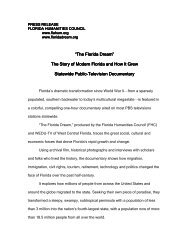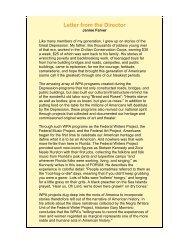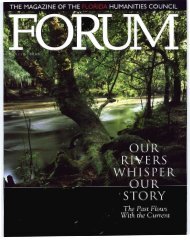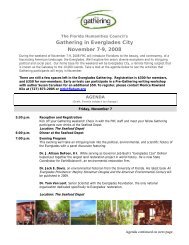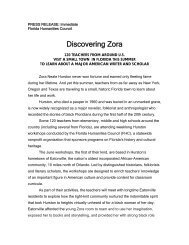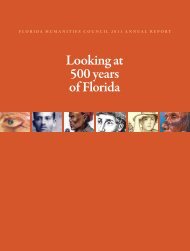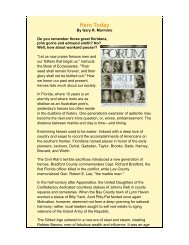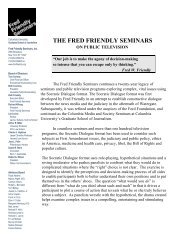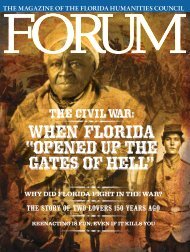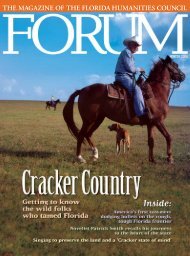The most momentous event in the history of Florida occurred ...
The most momentous event in the history of Florida occurred ...
The most momentous event in the history of Florida occurred ...
You also want an ePaper? Increase the reach of your titles
YUMPU automatically turns print PDFs into web optimized ePapers that Google loves.
Noble Waters<br />
By Bill Belleville<br />
A river s<strong>in</strong>gs a holy song convey<strong>in</strong>g<br />
<strong>the</strong> mysterious truth that we are a<br />
river...An enchanted life demands an<br />
appreciation <strong>of</strong> this flow.<br />
- Thomas Moore<br />
That night we came to a very wide,<br />
very deep and swift river, which we did<br />
not dare cross on rafts...A horseman<br />
named Juan Velázquez, native <strong>of</strong><br />
Cuéllar, entered <strong>the</strong> river without<br />
wait<strong>in</strong>g, and <strong>the</strong> swift current knocked<br />
him <strong>of</strong>f his horse, but he held on to <strong>the</strong><br />
re<strong>in</strong>s, and both he and <strong>the</strong> horse drowned.<br />
-Alvar Nunez Cabeza de Vaca,<br />
on gett<strong>in</strong>g lost <strong>in</strong> <strong>Florida</strong> <strong>in</strong> 1528<br />
I was paddl<strong>in</strong>g through <strong>the</strong> treetops <strong>of</strong> a <strong>Florida</strong> river <strong>the</strong> o<strong>the</strong>r day,<br />
soar<strong>in</strong>g through <strong>the</strong> foliage canopy like a giant bird. Heavy limbs <strong>of</strong><br />
ancient live oaks were flopp<strong>in</strong>g lazily <strong>in</strong> <strong>the</strong> current as if <strong>the</strong>y were<br />
metronomes keep<strong>in</strong>g time to <strong>the</strong> river's pulse. <strong>The</strong> gunnels <strong>of</strong> my kayak<br />
came with<strong>in</strong> a few feet <strong>of</strong> a tattered blue-jay nest still cradled <strong>in</strong> a branch.<br />
O<strong>the</strong>r limbs bristled with <strong>the</strong> spiky leaves <strong>of</strong> p<strong>in</strong>e bromeliads, and once<br />
with a green fly orchid, all just <strong>in</strong>ches above <strong>the</strong> water.<br />
<strong>The</strong> river was <strong>the</strong> Econlockhatchee, and a series <strong>of</strong> tropical storms had<br />
filled its valley <strong>of</strong> paleo-dunes to overflow<strong>in</strong>g. A month earlier, it had<br />
been a shallow sandy-bottomed blackwater stream that you could have<br />
walked across. A year before, ra<strong>in</strong> had been so sparse that it stopped<br />
flow<strong>in</strong>g, and it was less a river and more a series <strong>of</strong> narrow sloughs. But<br />
now it was high and rag<strong>in</strong>g, full <strong>of</strong> eddies and little stand<strong>in</strong>g waves.<br />
Like everyth<strong>in</strong>g else <strong>in</strong> <strong>Florida</strong>, our rivers resemble few o<strong>the</strong>rs back on<br />
<strong>the</strong> cont<strong>in</strong>ent. Indeed, <strong>in</strong> various stages <strong>of</strong> our wet-dry seasons, <strong>the</strong>y<br />
don't even resemble <strong>the</strong>mselves. Gravity makes <strong>the</strong>m work, <strong>of</strong> course,<br />
but it's a dist<strong>in</strong>ctly <strong>Florida</strong>-driven gravity that pushes water across barely<br />
perceptible gradients on <strong>the</strong> landscape. Its source is not glaciers or<br />
snowmelt <strong>of</strong> <strong>the</strong> mounta<strong>in</strong>s, but <strong>the</strong> superheated hydrological cycle <strong>of</strong>
our water-bound pen<strong>in</strong>sula. <strong>The</strong> liquid driv<strong>in</strong>g our rivers falls from <strong>the</strong> sky<br />
<strong>in</strong> extraord<strong>in</strong>ary amounts. <strong>The</strong>n, it ei<strong>the</strong>r ga<strong>the</strong>rs up <strong>in</strong>to swamps and<br />
marshes, or seeps downward <strong>in</strong>to <strong>the</strong> s<strong>of</strong>t limerock <strong>of</strong> our crust. Great<br />
wetlands like <strong>the</strong> Green Swamp brim and overflow, driv<strong>in</strong>g our rivers<br />
outward from it. Or <strong>the</strong> bone-white karst underfoot does likewise, its own<br />
underground rivers pushed to <strong>the</strong> surface by <strong>the</strong> unseen alchemy <strong>of</strong><br />
hydrostatic pressure from <strong>the</strong> uplands.<br />
Writers and poets (Harriet Beecher Stowe, William Bartram, Sidney<br />
Lanier) have variously considered our rivers wild, noble, or, given <strong>the</strong><br />
right mood, <strong>in</strong>dolent. Artists have delighted <strong>in</strong> <strong>the</strong>m, featur<strong>in</strong>g <strong>the</strong>m<br />
<strong>the</strong>matically <strong>in</strong> landscape pa<strong>in</strong>t<strong>in</strong>gs (William Morris Hunt, W<strong>in</strong>slow<br />
Homer, Herman Herzog). Musicians have been notoriously mixed on <strong>the</strong><br />
subject. <strong>The</strong> <strong>most</strong> famous river (<strong>the</strong> Suwannee) was celebrated by a<br />
songwriter (Stephen Foster) who never saw it. Yet arguably <strong>the</strong> <strong>most</strong><br />
sublime composition (<strong>Florida</strong> Suite) about a <strong>Florida</strong> river (<strong>the</strong> St. Johns)<br />
had <strong>the</strong> very legitimate franchise <strong>of</strong> be<strong>in</strong>g romanticized by a composer<br />
(Frederick Delius) who lived on its banks and truly fell <strong>in</strong> love with it.<br />
Rivers have <strong>in</strong>fluenced where humans settled <strong>in</strong> <strong>Florida</strong>, and how <strong>the</strong>ir<br />
cultures were molded over centuries. <strong>The</strong> bounty <strong>of</strong> flow<strong>in</strong>g rivers fed<br />
<strong>the</strong>ir imag<strong>in</strong>ations as well as <strong>the</strong>ir appetites. Some <strong>of</strong> <strong>the</strong> earliest pottery<br />
<strong>in</strong> North America was created on <strong>the</strong> banks <strong>of</strong> <strong>the</strong> St. Johns. Artistic<br />
skills <strong>the</strong>re and elsewhere transformed wood <strong>in</strong>to eagles, owls, otters.<br />
Dugouts, carved first from longleaf and <strong>the</strong>n from cypress, became art<br />
with great utility.<br />
Industrious Americans enlarged on <strong>the</strong> notion <strong>of</strong> river transportation,<br />
add<strong>in</strong>g steam boilers and paddlewheels. Both ornate and serviceable,<br />
<strong>the</strong> baroque steamboats toured nearly every river deep enough to float<br />
<strong>the</strong>m, regardless <strong>of</strong> how torturous <strong>the</strong> meanders. "Land<strong>in</strong>gs" for <strong>the</strong><br />
steamboats emerged where <strong>the</strong>re were only feral woods, draw<strong>in</strong>g<br />
turpent<strong>in</strong>ers, timbermen, planters, and early tourist promoters to <strong>the</strong>m.<br />
When <strong>the</strong> steamboats gave way to railroads, <strong>the</strong> practical use <strong>of</strong> rivers<br />
waned; settlements created by boat traffic <strong>of</strong>ten dissolved <strong>in</strong>to <strong>the</strong><br />
detritus <strong>of</strong> <strong>the</strong> swamp: St. Francis, Suwannee Spr<strong>in</strong>gs, Ellaville. But, this<br />
was not always true and, every now and <strong>the</strong>n those settlements<br />
morphed <strong>in</strong>to modern cities, like Jacksonville. At o<strong>the</strong>r times, <strong>the</strong>y<br />
rema<strong>in</strong>ed modest and pleasantly retro, like Welaka and White Spr<strong>in</strong>gs.<br />
<strong>Florida</strong> rivers are predictable only <strong>in</strong> <strong>the</strong>ir uncerta<strong>in</strong>ty. <strong>The</strong> Econ is like<br />
<strong>the</strong> Suwannee <strong>in</strong> that it trickles from a swamp, courses through a dist<strong>in</strong>ct<br />
valley, and dramatically rises and falls with <strong>the</strong> season. But <strong>the</strong>
Suwannee, like many <strong>Florida</strong> rivers, is fed by spr<strong>in</strong>gs, and <strong>the</strong> Econ is<br />
not. O<strong>the</strong>r rivers, like <strong>the</strong> Hillsborough, are augmented both by spr<strong>in</strong>gs<br />
and by groundwater seep<strong>in</strong>g up through fractures <strong>in</strong> its bed. Some rivers<br />
are <strong>in</strong> fact long spr<strong>in</strong>g runs-like <strong>the</strong> Ichetucknee, Alexander, Juniper,<br />
Silver, and <strong>the</strong> Wekiva. But even <strong>the</strong>n, many <strong>of</strong> <strong>the</strong>se runs are fed<br />
seasonally by ra<strong>in</strong>fall leak<strong>in</strong>g out <strong>of</strong> <strong>the</strong>ir tannic swamps. In wet<br />
summers, <strong>the</strong> Wekiva is tea-colored; <strong>in</strong> dry w<strong>in</strong>ters, it is spr<strong>in</strong>g-clear<br />
aga<strong>in</strong>.<br />
Some rivers, like <strong>the</strong> Chatham and <strong>the</strong> Lopez <strong>in</strong> <strong>the</strong> western Glades and<br />
<strong>the</strong> Nassau above Jacksonville, are so tidal that <strong>the</strong>y are pushed less by<br />
gravity than by <strong>the</strong> moon and <strong>the</strong> sea. And a few rivers are not truly<br />
rivers at all-for <strong>in</strong>stance, <strong>the</strong> Indian River is a brackish lagoon that does<br />
not flow, except when driven by w<strong>in</strong>d. Marjorie Stoneman Douglas called<br />
<strong>the</strong> sawgrass prairie that is <strong>the</strong> Everglades a "River <strong>of</strong> Grass" because<br />
its waters do move, although one has to stand <strong>in</strong> it for a long time to<br />
realize it.<br />
We have more than 50,000 non-l<strong>in</strong>ear miles <strong>of</strong> rivers <strong>in</strong> <strong>Florida</strong>, which<br />
are more or less divided <strong>in</strong>to 1,400 named bodies <strong>of</strong> flow<strong>in</strong>g water. <strong>The</strong><br />
process <strong>of</strong> nam<strong>in</strong>g a river seems less to do with its size than <strong>the</strong> op<strong>in</strong>ion<br />
<strong>of</strong> <strong>the</strong> cartographer who got <strong>the</strong>re first. We have no "brooks" mapped <strong>in</strong><br />
<strong>Florida</strong>, but we have "creeks," which are somewhat similar. And we have<br />
"dead rivers," which lead <strong>in</strong>to aquatic cul de sacs, end<strong>in</strong>g navigationally<br />
but not biologically. We don't have "bayous," but we have "sloughs,"<br />
which are usually deep unmov<strong>in</strong>g patches <strong>of</strong> swamp. That is, until <strong>the</strong><br />
wet season, and <strong>the</strong>n <strong>the</strong>y become a dynamic part <strong>of</strong> <strong>the</strong> river once<br />
aga<strong>in</strong>.<br />
<strong>The</strong> proper names <strong>of</strong> rivers are like <strong>the</strong> waterways <strong>the</strong>mselves. <strong>The</strong>y are<br />
snapshots <strong>in</strong> time, chang<strong>in</strong>g course <strong>in</strong> <strong>the</strong> semantic landscape, not<br />
unlike a channel that will reconfigure itself through its floodpla<strong>in</strong>. In this<br />
way, our <strong>most</strong> historic river was variously known as Welaka (<strong>in</strong> Creek<br />
language); Mai (French); Rio Corrientes, San Mateo, and San Juan<br />
(Spanish); and, for now, it is <strong>the</strong> St. Johns. Fortunately, an unusually<br />
large number <strong>of</strong> river names first <strong>in</strong>vented by early Creeks still endure <strong>in</strong><br />
<strong>Florida</strong>. More <strong>of</strong>ten than not, <strong>the</strong>y describe features or animals ra<strong>the</strong>r<br />
than prais<strong>in</strong>g some European deed or conqueror: Withlacoochee (Small<br />
River), Oklawaha (Muddy), Sopchoppy (Oak Tree), Loxahatchee (Turtle<br />
Stream), Chassahowitzka (Hang<strong>in</strong>g or Open<strong>in</strong>g Pumpk<strong>in</strong>), Echashotee<br />
(Home <strong>of</strong> Manatee or Beaver), Pithlachascotee (Chopped Boat). Say<strong>in</strong>g<br />
those names out loud sometimes restores life to <strong>the</strong> traditional myth <strong>of</strong><br />
<strong>the</strong> river, if only for a little while.
If some names have morphed over time, <strong>the</strong> <strong>of</strong>ficial lengths <strong>of</strong> rivers<br />
have also been altered as new <strong>in</strong>formation is revealed. But this is<br />
problematic: Mistakes are so <strong>of</strong>ten repeated that <strong>the</strong>y have become fact.<br />
Al<strong>most</strong> all almanacs consider <strong>the</strong> 245-mile-long Suwannee <strong>the</strong> longest<br />
river when its course out <strong>of</strong> Georgia's Okefenokee Swamp is considered.<br />
Yet <strong>the</strong> St. Johns, which is 280 miles from its navigational headwaters at<br />
Lake Hell 'n Blazes, is longer by at least 30 miles, and its entire length<br />
lies with<strong>in</strong> <strong>Florida</strong>'s boundaries. (When its headwaters are factored <strong>in</strong>,<br />
<strong>the</strong> St. Johns becomes at least 60 miles longer.)<br />
Certa<strong>in</strong>ly, figur<strong>in</strong>g <strong>the</strong> size <strong>of</strong> a river is tricky bus<strong>in</strong>ess all by itself. For<br />
<strong>of</strong>ficial purposes, <strong>the</strong> "ma<strong>in</strong>stem" or ma<strong>in</strong> channel <strong>of</strong> a river is usually<br />
considered its "length." But a river may have literally hundreds <strong>of</strong> miles<br />
<strong>of</strong> tributaries, branches, sloughs, and spr<strong>in</strong>g runs <strong>in</strong> its larger ecological<br />
system. And it is <strong>the</strong> watershed itself-all <strong>the</strong> vast terra<strong>in</strong> dra<strong>in</strong><strong>in</strong>g <strong>in</strong>to a<br />
river system-that is <strong>the</strong> key to <strong>the</strong> river's health. Modern Floridians might<br />
not understand that although <strong>the</strong>y may live miles from a channel, <strong>the</strong>ir<br />
actions trickle down to it through its watershed. Indeed, <strong>the</strong>ir<br />
predecessors may have chosen <strong>the</strong>ir geographic homes because <strong>of</strong> its<br />
location <strong>in</strong> <strong>the</strong> scheme <strong>of</strong> all th<strong>in</strong>gs. In a state as wet as <strong>Florida</strong>, it was<br />
always wise to know exactly what was upstream.<br />
<strong>The</strong> promise <strong>of</strong> modern "water management" seduces us <strong>in</strong>to th<strong>in</strong>k<strong>in</strong>g<br />
<strong>the</strong> flow <strong>of</strong> our rivers will always be protected. Meanwhile, affluent, thirsty<br />
regions scheme to commandeer spr<strong>in</strong>gs and river water-and we refuse<br />
to allow growth to be l<strong>in</strong>ked to water availability. Managed by politics<br />
<strong>in</strong>stead <strong>of</strong> ecology, our rivers dim<strong>in</strong>ish.<br />
Yet, our state's aquatic assets cont<strong>in</strong>ue to be promoted <strong>in</strong> <strong>the</strong> name <strong>of</strong><br />
nature tourism. This dilemma seems <strong>the</strong> best example <strong>of</strong> negative<br />
capability-<strong>of</strong> be<strong>in</strong>g able to hold two diametrically opposed ideas <strong>in</strong> your<br />
head at one time and still function.<br />
Confused? So was I, for a long time. At some po<strong>in</strong>t, I decided to forsake<br />
logic-s<strong>in</strong>ce it wasn't gett<strong>in</strong>g me anywhere-and to become more <strong>in</strong>timate<br />
with rivers <strong>in</strong> <strong>the</strong> hope that this would lead to a new way <strong>of</strong><br />
understand<strong>in</strong>g. I would stand <strong>in</strong> rivers to my chest to fly fish; I'd swim <strong>in</strong><br />
<strong>the</strong>m, paddle over <strong>the</strong>m, snorkel, and dive under <strong>the</strong>m, and camp on<br />
<strong>the</strong>ir shores. I would experience <strong>the</strong>m with friends, especially those<br />
will<strong>in</strong>g to open <strong>the</strong>mselves to <strong>the</strong> nuances and quirks and glories <strong>of</strong> <strong>the</strong><br />
rivers' spirits. I would read <strong>of</strong> <strong>the</strong>m <strong>in</strong> nonfiction books and novels,<br />
essays and poems, and scientific reports. I would delight when I found
an old map that traced a meander or illustrated a branch that no longer<br />
existed.<br />
Sometimes, I would go out on a river alone, shoulder<strong>in</strong>g my kayak to <strong>the</strong><br />
edge <strong>of</strong> <strong>the</strong> water at <strong>the</strong> ocher light just before dusk, and paddle until it<br />
was well after dark. Dipp<strong>in</strong>g my paddle spar<strong>in</strong>gly to steer, I would drift<br />
downstream with <strong>the</strong> slight current, not unlike a patch <strong>of</strong> float<strong>in</strong>g<br />
hyac<strong>in</strong>ths. Alone <strong>in</strong> <strong>the</strong> river darkness, I would brea<strong>the</strong> slowly and<br />
imag<strong>in</strong>e myself as nearly <strong>in</strong>visible. Wad<strong>in</strong>g birds would screech from <strong>the</strong><br />
dense river<strong>in</strong>e forest, fish would smack <strong>the</strong> surface to feed, and<br />
alligators would beg<strong>in</strong> <strong>the</strong>ir slow patient survey <strong>of</strong> <strong>the</strong> dark primal water,<br />
reclaim<strong>in</strong>g <strong>the</strong> river as completely as <strong>the</strong> night itself. Without <strong>the</strong> noise <strong>of</strong><br />
my clumsy modern ego to drown everyth<strong>in</strong>g out, <strong>the</strong> river would rega<strong>in</strong><br />
its preem<strong>in</strong>ence and grace; and when I had <strong>the</strong> courage to allow it, it<br />
would rise up to touch my soul. If I was lucky I could reach a s<strong>in</strong>gular<br />
place nurtured by <strong>the</strong> full emotional sway <strong>of</strong> bliss, <strong>of</strong> respect, <strong>of</strong> fear. It<br />
was an experience beyond <strong>the</strong> safeguard <strong>of</strong> <strong>in</strong>tellect.<br />
Once, after spend<strong>in</strong>g years around a river, I wrote a book about it. In<br />
do<strong>in</strong>g so, I talked to scientists and river dwellers and read everyth<strong>in</strong>g I<br />
could f<strong>in</strong>d on <strong>the</strong> subject, from research papers to poetry. Even <strong>the</strong>n, I<br />
could not capture it fully; for to write about a river is not unlike sculpt<strong>in</strong>g<br />
clay that is never put <strong>in</strong>to a kiln. It's malleable, someth<strong>in</strong>g that is<br />
remolded over time. If we expect it to stay put, we are badly mistaken;<br />
for rivers-even those bulk-headed and channeled-tend to break loose<br />
every once <strong>in</strong> a while. Secrets, hidden well, slowly reveal <strong>the</strong>mselves,<br />
like totems <strong>in</strong> <strong>the</strong> benthic mud. Rivers have a mystic quality to <strong>the</strong>m, a<br />
way <strong>of</strong> help<strong>in</strong>g us remember someth<strong>in</strong>g we thought we had forgotten.<br />
<strong>The</strong> process <strong>of</strong> appreciat<strong>in</strong>g <strong>Florida</strong> rivers has noth<strong>in</strong>g whatsoever to do<br />
with ownership or territoriality. To love a river enough to want to write<br />
about it, pa<strong>in</strong>t an image <strong>of</strong> it, or compose a song to it is to have <strong>the</strong><br />
capacity to at once hold tight to it-and, just as completely, to let it go.<br />
BILL BELLEVILLE is an award-w<strong>in</strong>n<strong>in</strong>g author and documentary<br />
filmmaker who specializes <strong>in</strong> environmental issues. He lives <strong>in</strong> Sanford.



